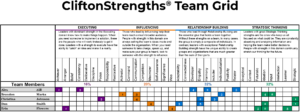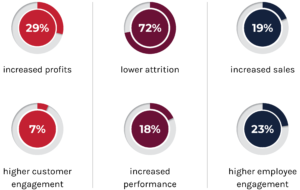At The Clearing, we help leaders and their teams reach their maximum potential and accomplish organizational goals by using a strengths-based approach. Part of that requires identifying the inherent talents within a team and using those as the foundation to build upon. One of the tools we employ to identify individual talents is the CliftonStrengths® Assessment. Today, our own Clifton – Clifton Johnson – will walk us through the tool and how we use it in our work.
What is the CliftonStrengths® Assessment?
The CliftonStrengths® Assessment is a tool we use to help individuals discover their natural talents. It helps identify the natural ways people think, feel, and behave. The assessment measures 34 talent themes and reveals which ones are more dominant for an individual. Organizations use this tool to help their employees identify and maximize their talents and strengths, and create a common language that enables peak workforce performance. CliftonStrengths® gives employees the opportunity to articulate and communicate their talents, understand the strengths of others, and then look for opportunities to leverage them effectively to achieve desired results.
Part of the CliftonStrengths® approach is learning how to turn individual talents into strengths. The idea is to identify your talents and then put time, effort, and energy into developing those talents until they become strengths. When we say strength, we mean the ability to consistently produce a positive outcome through near-perfect performance. It all adds up to helping employees determine their unique abilities that bring value to the greater team and organizational performance.
Tell us about your CliftonStrengths® coaching experience and helping organizations leverage it.
Here at The Clearing, I’ve used CliftonStrengths® as part of several projects where we’ve coordinated the distribution of the assessment, analyzed the results, and conducted individual leadership coaching and workforce coaching. Most of these centered on leadership development and building strengths-based teams to foster exceptional workforce performance. We typically begin these projects with individual coaching sessions with leaders to help them understand the assessment and how it can be used. This includes reviewing their own CliftonStrengths® assessment in a one-on-one session and discussing desired outcomes the leader is hoping to achieve through individual coaching and team sessions.
Following that level set, we facilitate team sessions that allow a deeper dive with each of the team members to name, claim, and aim their individual and collective talents and strengths. Our Strengths In Action sessions are designed to help the team advance from “who we are” to “what we will do.” During the session, we utilize various tools and visuals that guide the conversation. One of my favorites is the team grid, which visually displays participants’ strengths together which shows the presence of the team’s potential and enables the discovery of how dominant talents are showing up in team dynamics. We find this to be beneficial in two ways.

Gallup CliftonStrengths®
First, it helps team members build awareness of their colleagues’ talents and strengths and “explains” observed behaviors. For example, there may be a perception that Bob is a slow worker. However, one of Bob’s strongest themes turns out to be Deliberative®. It helps reframe “slow” into evaluating all possibilities before finalizing a deliverable.
Second, it helps leaders better understand team dynamics when constructing working groups and arms team members with a new perspective on what they and their colleagues bring to those groups. This is highly effective: GALLUP®’s research shows that organizations focused on strengths-based development reap tangible benefits, including increased profitability, higher customer engagement, and lower rates of attrition.

What advice can you offer leaders considering the CliftonStrengths® Assessment for their team?
Overall, I would encourage almost any leader to offer the assessment to their teams. At the least, it will help the leader better understand their employees and provide the team with a new perspective on how their colleagues work. There are also a few more benefits and tips in addition to what we’ve discussed above that I’d like to highlight.
- Crafting Organizational Goals: When considering performance goals, CliftonStrengths® can be used as a way to frame the conversation around how you can achieve that particular goal by leveraging the talents and the strengths within the team. A team grid is a valuable tool to use when engaging in these conversations.
- Coaching Benefits: Utilize an experienced coach to facilitate your team’s CliftonStrengths® Assessment sessions. Once a team has taken the assessment, GALLUP® provides a wealth of information. Simply sorting through it and determining how to use it is a challenge. Employing an experienced partner can help a team get the most out of the assessment through efficient use of the outcomes and post-assessment tools.
- Realizing Results: The benefits of a strengths-based culture are real. In addition to the metrics above, GALLUP® studies show a positive effect on overall team member wellbeing and engagement. So, if an organization is looking at ways to increase employee engagement or group cohesion in addition to workforce performance, the CliftonStrengths® Assessment is a great place to start.
If you’d like to learn more about how the CliftonStrengths® Assessment may help your team maximize workforce performance or are seeking a partner to lead your organization through the exercise, please reach out or download our 1-pager. I am available to chat at Clifton.Johnson@dev2021.theclearing.com.
Clifton’s Top 5 CliftonStrengths®: Empathy, Harmony, Connectedness, Relator, Learner
